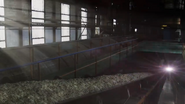A sugar refinery processes raw sugar from cane or beets into white refined sugar. Many cane sugar mills produce raw sugar, which is sugar that still contains molasses, giving it more colour than the white sugar which is normally consumed in households and used as an ingredient in soft drinks and foods. While cane sugar does not need refining to be palatable, sugar from sugar beet is almost always refined to remove the strong, usually unwanted, taste of beets from it.[1]
Coverage[]
Sugar refineries are featured in The Last Supper.
It was introduced in 2 days after people when sugar begins to show a side that's not sweet. The show gave information that 10 million tons of sugar was annually pumped out of 30 refineries scattered across the United States, just a fraction of the 18 billion pounds consumed in the US every year. The process is done by converting the juices from sugar cane and sugar beets into crystals, but the process creates clouds of dust and it can be flammable. Steven S. Ross stated that sugar dust, flour dust, and any wide variety of crystalline materials build up static charges as little dust particles rub against one another.
The clouds of sugar dust become a ticking time bomb even in the time of humans were 4 sugar refineries explode in the United States due to a buildup of sugar dust in the air. Human engineers tried to alleviate the risks through various means including proper ventilation and minimizing the overheating of machinery, but without people, the safety measures are no longer in operation, especially when power fail. In one refinery, static electricity ignites the sugar dust inside the conveyor belt causing a fire and the dust fuel fireball travels to the two 100 foot silos which contribute to the growing disaster. Tanya Komas stated that if the fire were continue and reach the level of 700 degrees, the moisture in the concrete in the aggregates that turns to steam at the high temperature would explode. The fire cause the explosion at the silos then mounds of sugary sludge squash out and solidify like cement. Steven S. Ross stated if the fire gets hot enough, the caramel decomposes into constituents that will burn and it will have an enormous fire. The fate is sealed as the entire sugar refinery exploded.






